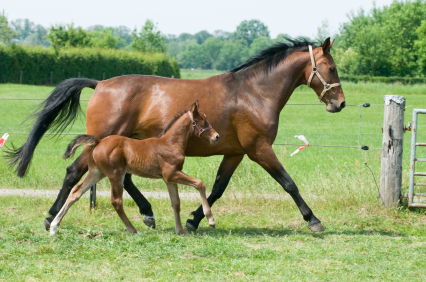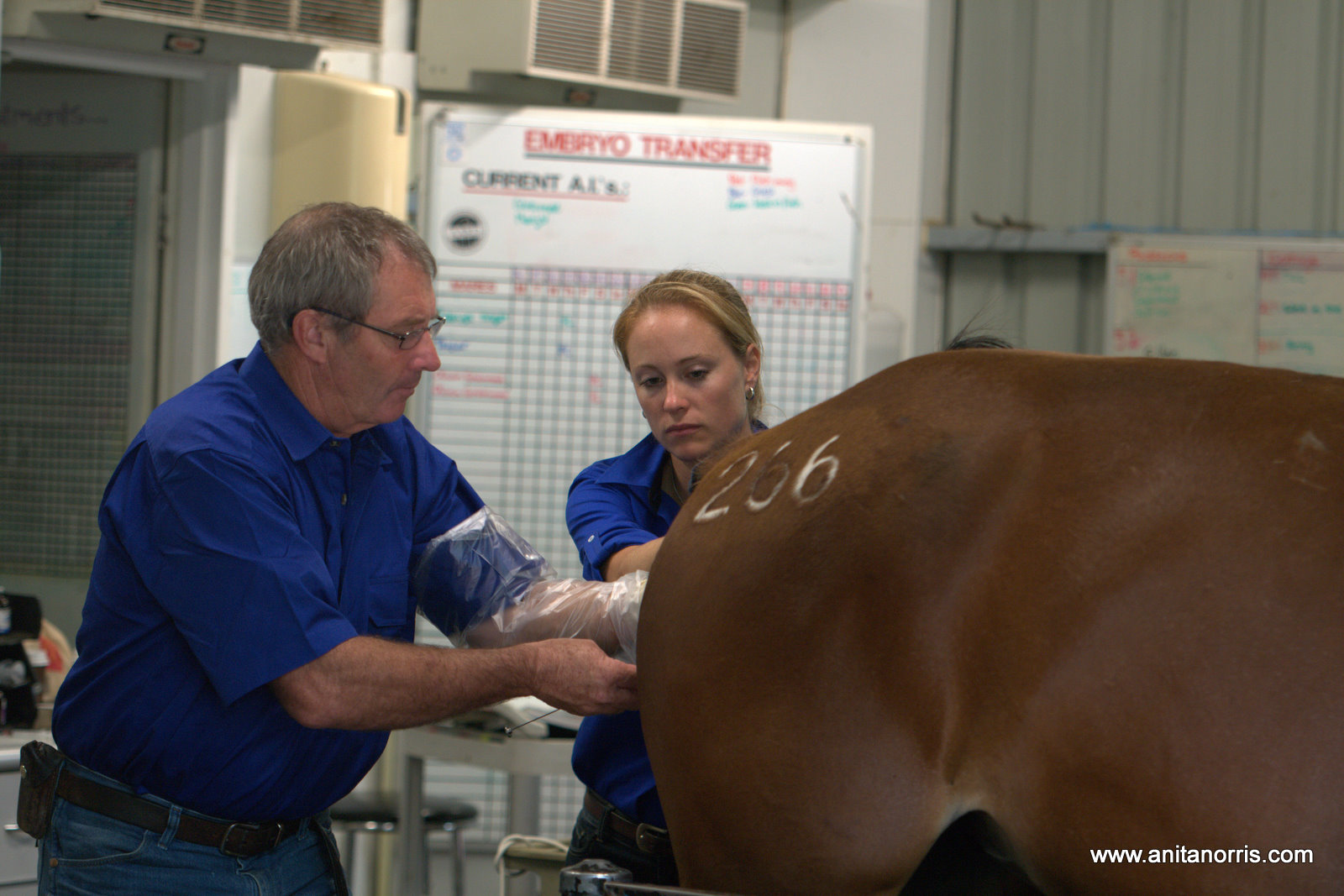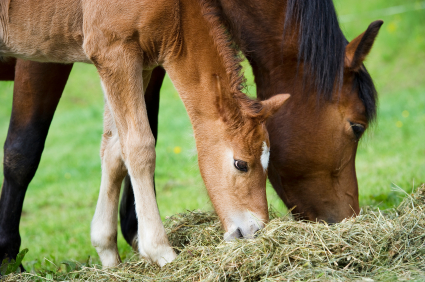 Breeding your mare is a big decision and the prospect can seem quite overwhelming - there is so much to research, organize and plan for as well as many different people to coordinate with. To make this process as stress free as possible, for everyone involved, it pays to be organized. The planning process will be a lot more enjoyable and exciting when you have everything lined up and are not surprised or caught off guard by any unexpected fees, decisions or situations. In this article, we have some suggestions for how you can be more organized for breeding season by considering what needs to be done before the season begins, when it's time to breed, before your mare foals, and once your new foal hits the ground.
Breeding your mare is a big decision and the prospect can seem quite overwhelming - there is so much to research, organize and plan for as well as many different people to coordinate with. To make this process as stress free as possible, for everyone involved, it pays to be organized. The planning process will be a lot more enjoyable and exciting when you have everything lined up and are not surprised or caught off guard by any unexpected fees, decisions or situations. In this article, we have some suggestions for how you can be more organized for breeding season by considering what needs to be done before the season begins, when it's time to breed, before your mare foals, and once your new foal hits the ground.
In Advance of Breeding Season:
Choose a Mare
Many breeders support the notion that the mare constitutes more than 50% of the equation when it comes to the type and personality of your foal. Primarily because she not only provides 50% of the genetics, but she will also be responsible for raising the foal; so her temperament and behavior can impact the foal as well. Therefore, start with a mare that you LIKE, especially since you will be spending a lot of time with her in the coming year. Study your mare, understand her weaknesses and know what aspects of her conformation and movement you would like to improve upon with this breeding.
Choose a Stallion
Researching stallion prospects can be so much fun - resulting in endless day dream possibilities. But before getting carried away surfing on the internet for potential suitors, take some time to consider what your breeding goals are and what you are looking for in a stallion. For example, which discipline is the foal intended for, do you plan to sell him or raise him for yourself, are you aiming for upper level potential or a reliable and enjoyable mount for an amateur. What do you need to improve upon in your mare and what characteristics are important for the stallion to hold.
Find a Vet
To locate an equine reproduction veterinarian in your area you may find the following websites helpful:
AAEP Vet Search or SFT Vet Search
Will you be using cooled or frozen semen? Will this be an embryo transfer? Talk to your veterinarian to be sure they have the credentials and experience required for your breeding management requirements. Also, what availability do they have outside of regular business hours? For example, if you are planning a one dose frozen semen breeding, can they make every 6hr ultrasound checks? How much advance notice do they need when making an appointment? Will they come to your farm or do you have to take the mare to them? Most importantly know what their fees are and any requirements (health testing, vaccinations) if bringing the mare into their clinic. If this is an embryo transfer and you don’t have access to your own recipient mares, you will also need to research options for recipient mare herds.
Plan for the Foal’s Arrival
It may still be over a year before the foal is born; nonetheless it is still a good idea to plan for where the foal will be born. If you do not have the facilities at home to foal out your mare, research what options you have available in your area, stalls may fill up fast and advance reservation may be required.
Registration
Decide now which breed registry you intend to register the foal with when it’s born. The requirements for registration vary with each breed organization and it is important to know what fees and paperwork (e.g. breeding certificate) is required for registration. You may wish to present your mare to a new registry for inspection and approval before she is bred and if so should allow time for this.
Budget
Breeding horses can be an expensive endeavor. Be proactive and prepare a budget ahead of time, estimating all the expenses you anticipate in stud fees, shipment fees, breeding and foaling fees. Consider the best case scenario and the worst case scenario. Certainly you should budget for 2 to 3 breeding cycles. If you intend to sell the foal and make a profit, it may be advisable to set a limit to your spending, to ensure the cost of producing the foal doesn’t exceed the market value when he hits the ground. Be sure to have access to additional funds in case of an emergency, and consider insuring your broodmare.
Plan for the Unexpected
No one likes to think about the “worst case scenario”, and we all hope your breeding venture is a positive success, however, breeding can be a risky business and it is important to be prepared for all eventualities. What if your mare does not conceive, do you have another mare you could transfer the breeding to? What if she rejects the foal, or sadly dies after foaling. Know what your options are for a nurse mare. Think about all eventualities and how you will resolve them should they arise.
Before Breeding Season Begins:
Breeding Soundness Exam
We recommend that you perform a breeding soundness exam on your mare at the start of the breeding season, or before purchase if you are buying the mare specifically to be a broodmare. Determining that the mare is reproductively sound can save significant time and money in the long run. Some stallion service contracts may require the mare be cultured before semen will be shipped, check your breeding contract to see what obligations you have agreed to as a mare owner. See our blog article - Preparing Your Mare for Breeding
Review Collection and Shipment Schedules
Review the availability for semen collection and shipment, i.e. when does the breeding season start and end, can they collect every day of the week, are there any dates the stallion will not be available for collection (e.g. if he’s away at a show or on national holidays), can you get FedEx Saturday delivery in your area and can they airline semen if required? If this is a frozen semen breeding, is the semen shipped by the owner/agent or by a storage and distribution center? Who do you call to request a semen shipment - the stallion owner, the agent, the breeding farm manager where he stands or the distribution center where his semen is stored? Is there a cut-off time by which shipment requests must be received?
Review the Costs Involved
Be clear in your understanding about the fees you will be responsible for at the time of semen shipment. In most cases a shipment won’t be sent unless you have paid your stud fee in full and there is a check or credit card on file to cover the first shipment.
When It’s Time to Breed:
Heads up to Stallion Owner
Give the stallion owner a heads up when your mare is close to being bred, this can help them plan collection schedules, so as to appropriately manage all the mares the stallion will service in the upcoming week. Especially if this is an early collection at the start of the breeding season, as the stallion may require clean out collections before shipment. For frozen semen shipments the stallion owner will be required to authorize the storage and distribution center to release semen to you for shipment.
Requesting Semen
When you call in to request a semen shipment have all your information and credit card ready and available to relay to the stallion owner/agent or semen collection/storage facility. If your vet clinic or breeding manager will be requesting the semen shipment, be sure they have this information available. Inspect the shipment upon arrival, and if there are any problems or concerns notify the stallion owner immediately.
Breeding and Pregnancy Check
Review with your veterinarian about how the mare was managed during the breeding cycle. Don’t be afraid to ask questions if you don’t fully understand what is being explained to you. Does the mare require any post-breeding exams or treatment? Schedule your appointment for the pregnancy check and good news or bad, be sure to relay this information to the stallion owner. If your mare is not pregnant, discuss with your veterinarian the management plan for your mare on the next breeding cycle.
Return Paperwork and Tank
If insemination certificates are required to be returned to the stallion owner be sure your veterinarian or breeding manager completes and returns them. Also in order to avoid late fees or forfeit of your tank deposit, return the semen shipper in a timely manner.
Before Foaling:
Ensure Correct Nutrition for Mare and Foal
Once your mare is bred, it is time to plan for the nutritional and health requirements of your pregnant mare. For the first half of her pregnancy, your mare’s diet may stay the same; however, her nutritional requirements will increase towards the end of her pregnancy. Work with a nutritional consultant to formulate a complete and balanced diet for your pregnant mare. Consult with your veterinarian regarding vaccination and worming schedules. It is important for your mare to be vaccinated against Equine Herpesvirus 1 (EHV-1) in the 5th, 7th and 9th month of pregnancy. Vaccination guidelines can be found on the AAEP website. To avoid pregnancy complications or abortion due to endophyte-infected tall fescue, your mare should be removed from pastures containing tall fescue 60 days before her due date.
Prepare for Foaling
It is considered good practice to move your mare to the farm where she will foal at least 30 days before her due date. If you are foaling your mare at home, be sure to have a complete foaling kit on hand and emergency plans in place, e.g. where is your closest emergency clinic and check there is a full tank of gas in the truck and trailer.
After Foaling:
Foal Exam
 The foal should be examined by a veterinarian as soon as you can arrange it. Ideally an IgG blood test is performed 12 to 16 hours after birth to ensure the antibodies supplied by the mare's colostrum have been sufficiently absorbed by the foal.
The foal should be examined by a veterinarian as soon as you can arrange it. Ideally an IgG blood test is performed 12 to 16 hours after birth to ensure the antibodies supplied by the mare's colostrum have been sufficiently absorbed by the foal.
Let the Stallion Owner Know
Share the good news of the birth with the stallion owner, so they can update their records.
Complete Breed Registration
Coordinate with the stallion owner and breed registry to complete the reqistration requirements for your foal. This will usually involve pulling mane or tail hairs for a DNA test.
Once your foal has arrived safely and both mare and foal are doing well, you can breathe a big sigh of relief and take pride in your accomplishment. Now the enjoyment and responsibility of raising your foal to be everything you had hoped for begins. Enjoy this time with your young foal now - they grow so fast!
See Also:
How to Prepare the Older Mare for Breeding


Log in to join the conversation.